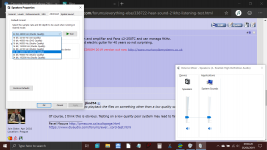Can you hear the difference between the files? They are both coded as 96kHz/32bit wav files. One of the files is sharply cut above 21 kHz and the other one has sound frequencies up to 30-40 kHz. Can you tell the difference by listening? Then vote in the poll. Do you have a positive ABX test report? Then please post it and your result will be considered as very serious. The files are uploaded at dropbox
Dropbox - mustgo.zip - Simplify your life
You do not need to have a dropbox account. Click somewhere outside log-in window and then click to download (top right corner of the screen) the mustgo.zip file. Do no try to play the files directly from dropbox, it is impossible.
Dropbox - mustgo.zip - Simplify your life
You do not need to have a dropbox account. Click somewhere outside log-in window and then click to download (top right corner of the screen) the mustgo.zip file. Do no try to play the files directly from dropbox, it is impossible.
What the human ear is detecting is both sound pressure and a lower harmonic.
The human ear cannot physically 'hear' above 18.5kHZ and as one gets older the higher frequencies that can be heard, reduce down to around 12kHZ.
Line Time Base frequency of 625line TV is 15.625kHZ and most people could not hear that, all they can hear is the ringing of tuning coils.
The human ear cannot physically 'hear' above 18.5kHZ and as one gets older the higher frequencies that can be heard, reduce down to around 12kHZ.
Line Time Base frequency of 625line TV is 15.625kHZ and most people could not hear that, all they can hear is the ringing of tuning coils.
Last edited:
Now, what is the "sound difference" between the files? To answer the question, I have created a difference file (direct subtraction), which was then amplified about 20dB and then 3 times slowed down, to transfer ultrasound into audible range. That means, the content between 21kHz - 48kHz was transferred to 7kHz - 16kHz frequency band. Now we can hear that there is not only noise, but also high frequencies and transients. This is the amplified and slowed difference between the files, this is the ultrasound transferred into the audible zone.
Dropbox - mustgodiffslow.zip - Simplify your life
Dropbox - mustgodiffslow.zip - Simplify your life
Many humans can sense ultrasound in the roughly 25 kHz domain. But not as a sound per se.
The muscles of the inner ear tighten in response to loud sounds, lowers the gain in essence.
If you are casually listening to something and suddenly U/S is introduced, there will be a lowering of appearant volume.
Within the context of a riding U/S signal, I do not know if such a diff can be heard.
Jn
The muscles of the inner ear tighten in response to loud sounds, lowers the gain in essence.
If you are casually listening to something and suddenly U/S is introduced, there will be a lowering of appearant volume.
Within the context of a riding U/S signal, I do not know if such a diff can be heard.
Jn
Now, what is the "sound difference" between the files? To answer the question, I have created a difference file (direct subtraction), which was then amplified about 20dB and then 3 times slowed down, to transfer ultrasound into audible range. That means, the content between 21kHz - 48kHz was transferred to 7kHz - 16kHz frequency band. Now we can hear that there is not only noise, but also high frequencies and transients. This is the amplified and slowed difference between the files, this is the ultrasound transferred into the audible zone.
Dropbox - mustgodiffslow.zip - Simplify your life
That is 3rd harmonics. All musicians understand that phenomenon but one cannot 'hear' the actual base frequency.
The clue here is 'Ultrasound'; in audible to the human ear.
Many humans can sense ultrasound in the roughly 25 kHz domain. But not as a sound per se.
The muscles of the inner ear tighten in response to loud sounds, lowers the gain in essence.
If you are casually listening to something and suddenly U/S is introduced, there will be a lowering of appearant volume.
Within the context of a riding U/S signal, I do not know if such a diff can be heard.
Jn
You have 2 files, one with ultrasound content, the other cut at 21kHz. Anyone can try what he/she would hear. As studies show, ultrasound hearing in presence of standard bw sound was a result of intermodulation.
The slowed down difference file posted is just an interesting addition, not a matter of test.
One must also note to playback the files on something other than a low quality sound card with budget earphones/pc speakers...
Of course, I think this is obvious. Testing on a low quality poor system may lead to false differences created by system artifacts.
This is the problem I seem to hit with these tests (soundcard quality). The only options I have are these (default setting shown).
For what its worth I had three ABX attempts and got between 14.5% and 35% or so and yet I felt one file had a more fatiguing sound than the other at HF. As so often happens, that couldn't be translated to a positive ABX result.
For what its worth I had three ABX attempts and got between 14.5% and 35% or so and yet I felt one file had a more fatiguing sound than the other at HF. As so often happens, that couldn't be translated to a positive ABX result.
Attachments
- Status
- This old topic is closed. If you want to reopen this topic, contact a moderator using the "Report Post" button.
- Home
- General Interest
- Everything Else
- Can you hear sound above 21kHz? - listening test
